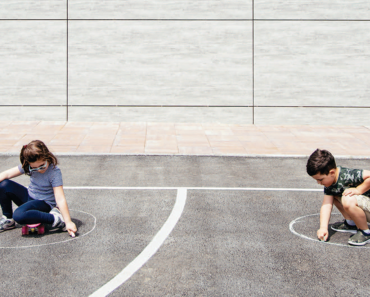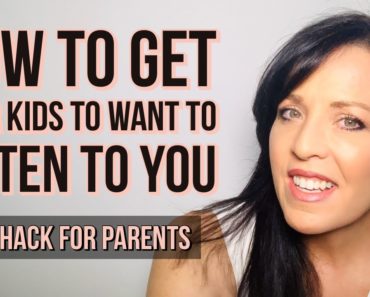Recently my husband and I bribed our three-year-old to stay in her bed all night by letting her wear her Queen Elsa dress to sleep. She began wearing it every waking (and sleeping) moment. And even though my house is now covered in glittery sparkles, our tactic worked, and I was so proud of my parenting hack.
Until, that is, my mom suggested I should be mindful of the amount of time my kids spend in synthetic fabrics. (The dress is made of polyester, elastane and a whole lotta glitter.) Parenting high over. Thank you, Irene.
At first, I laughed off this kernel of less-than-helpful commentary from my mom, but then the old familiar questions and doubts started rolling around in my head again. In the last couple of months alone, I have read reports of toxic chemicals found in clothes from popular fast-fashion Amazon brands, heavy metals in pre-made baby foods, been warned by a health blogger to not use scented candles in my home, and wondered if I should switch to a “natural” brand of bubble bath because my two toddlers spend the majority of their bath time drinking soapy water. (The youngest is one.)
When I became a parent for the first time, I did not expect to question the chemicals in my food and household supplies to this degree. Plastic sippy cups, diaper brands, baby skin moisturizers, even sunscreen—it all felt like a threat.
Professionally, I’ve worked in the Canadian agriculture sector for more than a decade, so I consider myself well versed on issues related to modern food production, and the organic vs. non-organic debate. I have interviewed countless farmers, food scientists and agriculture researchers—often themselves parents—who believe 100 percent in the need for chemicals, at approved levels, in food and products. I know how to read scientific studies and interpret complex information.
And yet, the first time a tiny newborn was laid on my chest, my brain was re-wired completely around the constant, burning need to keep her safe, which means spending countless hours trying to figure out which threats are real and which are perceived.
For some parents, the real threats are chemicals. This makes sense: in the past decade, toxic chemicals in food and household products have been linked to all sorts of scary health afflictions in kids (and adults), leading many parents to choose “organic,” “natural” and “non-toxic” products as much as possible.
Chanelle Morin is one parent not willing to take any risks. Morin, who lives with her family at Katepwa Lake, Sask. (just outside of Regina) chooses mostly organic food and lifestyle products for her family, including her three kids. She initially made the choice to go organic shortly after her first child was born, after being persuaded by her sister, who worked in a health food store.
“I changed our shampoo, deodorant and toothpaste over to natural stuff. That’s where we started. I noticed a huge change in my emotional health,” she says, adding she also liked using organic products for her kids as an alternative to traditional medicine. “I didn’t ever love giving my kids Tylenol and other medication. I hated taking them to the doctor.”
By the time she was pregnant with her third child, she felt so strongly about the products she was using, she became a sales rep for one of the brands she liked. “I’m very, very passionate about what we put on our bodies,” she says.
“My girls are getting to the age where they want to start using makeup and deodorant. I’ve explained to them that it can really mess up your reproductive system, your endocrine system, the respiratory system,” she says. “I think it’s really important to keep that stuff clean.”
Although the hard evidence on these claims is mixed, some parents prefer to play it extra safe.
What are chemicals?
It’s important to remember that chemicals are not “good” or “bad,” says Joe Schwarcz, a chemist and director of McGill University’s Office for Science and Society. They’ve just gotten a bad rap.
“Chemicals are just the building blocks of matter,” he says. “Everything in the world is composed of chemicals.” Something as harmless as apples—even the so-called “all-natural” ones— contain more than 300 naturally occurring chemicals, including some of the same ones that parents will avoid in certain products (think acetone, isopropanol and cyanide).
Schwarcz believes that the rise in fear of chemicals has coincided with the evolution of the Internet and the mass sharing of information. “People are exposed to more information than ever before,” he says. “There’s a lot of sound information, but there’s a lot of misinformation as well.” (This has become especially prevalent during the prolonged anxiety of the COVID-19 pandemic, a time when it’s been hard for many to sort facts from fiction.)
Schwarcz also believes that since people have conquered many life-threatening diseases and medical concerns over the decades, we now have more time and mind space to worry about smaller, often more trivial, concerns. “As more and more products have invaded the marketplace, more talk has emerged about what they are and what they contain,” he says. Social media, with influencers and fellow parents promoting different “natural” product lines, has also played a role in amplifying or planting concerns some moms might not have even known they had.
Natural chemicals vs synthetic chemicals
Of course, marketing also plays a big role in fear-mongering and confusion over chemicals, especially with “natural” versus “synthetic” chemicals.
“In my more than 40 years in this business, the single biggest myth I have to fight is that if something is natural, it’s safe and desirable, and if something is synthetic, it’s dangerous and should be avoided,” Schwarcz says. Just because something occurs in nature doesn’t mean it’s safe. “Scorpion venom is natural,” he points out.
The crux of the issue
So what are the risks when it comes to exposing our kids to chemicals in food and household products? Unfortunately, there’s no simple answer and it can depend on who you ask.
Erica Phipps, executive director of the Canadian Partnership for Children’s Health and Environment (CPCHE), whose mission is to protect children’s health from environmental contaminants, believes that exposing our kids to toxic substances in household products, and in foods in utero and during childhood, has the potential to cause long-term harm—even at low exposure levels.
“The research is increasingly clear that even low-level exposures over time can alter the growing bodies and brains of our children, especially since we’re exposed to dozens of chemicals concurrently,” she says. “You may not see acute or observable effects in every case, but it’s the subtle long-term effects that have many of us very concerned.”
She says that certain studies have shown that toxic chemical exposure at low doses can harm immune systems and intellectual development in kids, and one area where this link is of increasing concern is with neurodevelopmental disorders. While she is not someone with extreme fringe beliefs, she does believe in a possible link between environmental factors and physical and emotional wellbeing.
“Autism and a number of learning and behavioural disorders are on the rise,” she says. “Many environmental health experts believe that exposure to environmental contaminants is among the factors leading to those increases.”
But Schwarcz says a link between toxic chemical exposure and human health problems is not that clear. First off, scientific literature on toxic substances tends to be based on research on animals, and tends to test applied chemicals at amounts way above suggested rates for human use, he says. Furthermore, any substance will cause adverse effects in some doses on animals or within lab experiments. For example, remember that Aspirin, in small doses, can prevent heart attacks, but in extremely high doses, can be deadly.
Another complication is that studies may show the presence of a chemical in an unhealthy human body, but that doesn’t necessarily mean the two are linked. “Associations cannot prove cause and effect,” says Schwarcz. The omnipresence of chemicals in our day-to-day lives makes it virtually impossible to pinpoint specific causes and effects in research. “We live in an incredibly chemically complex world,” he says.
What’s more, every single person is biochemically individual, meaning a substance that may affect one person may not affect another.
“The human body is the most complex machine on the face of the earth, in which there are thousands of chemical reactions going on, concurrently, all the time,” he says. When you add food and products into the mix, themselves composed of hundreds of thousands of different compounds at different doses, it becomes even more complicated. “You cannot combine these complex entities and come up with a simple solution,” he says. “People constantly search for the simple solution. But simple solutions are inevitably wrong.”
Who can we trust?
One question I keep coming back to, as a parent, is who can you trust to help you make these major decisions about which chemicals are harmful at which levels? When I go to a grocery store, can I assume the food and products on the shelves are safe, whether I’m buying organic or not? I asked Stuart Smyth, the Agri-Food Innovation & Sustainability Enhancement Chair at the University of Saskatchewan, for guidance. (His position is funded by the agriculture industry, but it’s meant to provide neutral scientific information to drive sustainability in the industry.)
He told me that Canada’s food safety system is doing a lot of work behind the scenes that we don’t even know about as consumers. “Our system is very effective and efficient,” he says.
Although not every single product on the grocery shelves has been checked to ensure that it meets Canada’s strict safety requirements, random sampling is done frequently. He says food safety failures are reported on a weekly basis.
These failures comprise any product that doesn’t meet Canada’s strict regulations around food, he says. “For example, a dairy product could be removed because it may contain traces of nuts that were somehow inadvertently mixed in at a processing point,” he says.
Consumers are also able to register through the Canadian Food Inspection Agency (CFIA) for food recalls. However, Phipps says her organization has been advocating for years for a more precautionary regulatory approach.
“We need regulatory decision-making that errs on the side of precaution. In other words, unless there is high confidence that a chemical will not pose risks to children’s health and development, we should not be allowing it in products, and in the places where our kids live, learn and play. Our societal failure to adequately apply this better-safe-than-sorry approach has led to all-too-common situations in which we find out, after the fact, that certain chemicals have been causing harm.”
One other complication to my question is that there are a lot of people giving advice on these matters who shouldn’t be, says Schwarcz.
“You have to look to see who is speaking, whether or not they have any potential financial gain or vested interest in what they are saying, and what their educational background is,” he says.
So what does all this mean for parents? There are no easy answers. It’s up to you to make these, potentially big, decisions.
Luckily, we are good at that. All day, every day, we assess potential risks and make the best decisions we can, given the evidence we have at that point as well as a suite of other factors, to ensure our kids are safe and happy.
And that’s all we can do.
To help you do so, here are some answers to common safety questions about household products and foods.
Is fluoride safe for kids?
Depending on where you live in Canada, your municipal water supply may be fluoridated. And for some parents, this poses health concerns.
Ask a dentist and they’ll say there’s no need to worry. In Canada, fluoride is allowed in water supplies at a level of 0.7 mg/L, or 0.7 parts per million (PPM), and at that level, the dental community has not seen any undesirable alterations or concerning side effects, says Bruce Yaholnitsky, a dentist and former president of the Alberta Dental Association and College Council. “The benefits far outweigh the very small risk factors of having high levels of it,” he says.
In fact, he says parents should worry if their municipality does not have community water fluoridation (or your home is not on a city water supply—if you have your own well, for instance). Since fluoride was first introduced in city water supplies across North America in the 1940s, it has been greatly successful at reducing tooth decay in kids—and adults, Yaholnitsky says. The United States’ Center for Disease Control and Prevention even named community water fluoridation “one of the greatest public health achievements of the 20th Century.”
But another concern for parents is the amount of fluoride in kids’ toothpaste, and what happens if they ingest it (which my toddler does routinely, despite my attempts to stop it). Again, Yaholnitsky says that amounts are important. “This is only a concern if you’re putting globs and globs of toothpaste on the brush,” he says. He recommends using a pea-sized amount for each brushing.
These concerns still cause many parents to opt for childrens’ toothpaste brands that are fluoride-free and organic. Yaholnitsky advises against these options, as fluoride is the best way to prevent tooth decay. “The most common reason for elective hospital cases for children under age five is dental problems,” he says. “That’s a higher risk to me.”
Is organic food better for kids?
There are endless health benefits commonly associated with going organic. The obstacle is that organic food and products are more expensive and often not as convenient to purchase.
So, is it worth it?
McGill chemist Schwarcz isn’t convinced. “We just don’t have any data that shows that people who eat solely organic are any healthier,” he says, and he would question the accuracy of any data that shows otherwise. “Chances are that people who are into the organic diet are also people who take better care of their health anyway.”
However, he also doesn’t see any harm in choosing organic food, especially if it brings people more peace of mind. “The bottom line is that you should be eating a diet that is loaded with fruits and vegetables, whether they’re conventional or organic.”
If you choose to purchase organic, make sure you fully understand what it means, says Smyth. If a food is labelled “organic,” it doesn’t necessarily mean there are no chemical residues in it. “There’s a misconception that chemicals aren’t allowed in the production of organic crops and foods,” he says. “Unfortunately, that’s a myth the Canadian organic industry likes to perpetuate.”
The CFIA allows 144 different naturally occurring chemicals to be applied to vegetables, fruits and bulk commodities like wheat or oats, Smyth says, and these products must be used in adherence with the same marginal residue limits in place for conventional food products.
Furthermore, both Schwarcz and Smyth believe there is a significant level of fraud in the organic industry, as it’s difficult to regulate an entire supply of produce. In 2014, a CBC News story reported that nearly half of organic food samples collected by the CFIA contained pesticide residues. In 2012 study from the Journal of International Food & Agribusiness Marketing, organic inspectors in Canada estimated that, at a minimum, 10 percent of food labelled organic actually isn’t.
Because of these complications, Smyth isn’t convinced that the risks are any different between conventional and organic food. “The risk of avoiding chemicals through the consumption of organic products wouldn’t be statistically different from any risks in consuming conventional food products.”
Are there really heavy metals in baby food?
A U.S. report released in 2019 had North American parents questioning what was in their baby foods.
It found levels of heavy metals including cadmium, lead, mercury, and inorganic arsenic above the maximum amounts allowed in rice cereals, sweet potato puree, juices and sweet snack puffs made by some of the most trusted household names, including Nestle and Gerber.
Health Canada followed up by announcing that testing the same products and brands in Canada had not revealed any concerns.
But parents were concerned nonetheless—and rightfully so.
Schwarcz says the first three questions any science expert would ask in this situation are: how much was found, how does that compare to what we know is toxic, and what was the level of exposure?
In this case, even when numbers are found to be above acceptable limits—which they were in some cases—there still isn’t great cause for concern, in his opinion.
“They found a particular sample which was higher than it should be,” he says, adding that doesn’t mean that those rates would be similar for all comparable products and all brands. It’s not realistic to test every single package or every single serving of every single product. “That doesn’t translate to a blanket statement about all infant foods,” he says.
Which sunscreens are safest for kids?
In 2019, a study from the U.S. Food and Drug Administration showed that the chemicals found in sunscreen may be more harmful to young kids than previously thought, which left parents worried about choosing the right product for their little ones.
Luckily there is some consensus amongst experts about best practices when it comes to best practices around sun exposure: “We want children to be protected from undue UV exposure,” Phipps says. “So that’s first and foremost.” Sunscreen can play an important role in this, as can playing in the shade and wearing protective clothing.
Generally, physical (mineral) sunscreens are favoured for kids. Currently, the concerns are mainly with the chemical blockers used in sunscreen, such as oxybenzone and octinoxate (octyl methoxycinnamate), says Phipps. “There is scientific research showing that those chemicals can move into and through the skin, and some have been associated with hormone disruption and other adverse effects,” she says.
She says if families have the choice, to opt for sunscreen products with physical blockers, such as titanium dioxide, as much as possible. Parents are also advised to use a broad-spectrum product that has the Health Canada UVA logo on it.
“Simple measures, such as wearing protective clothing and playing in the shade, are great ways that children can be protected from the sun’s harmful rays,” says Phipps.
Are BPAs and micro-plastics a concern?
Although bisphenol-A (BPAs) have been used in plastics that end up in consumer products, like reusable water bottles and the lining of food cans, for more than 50 years, concerns have been raised in recent decades about the safety of human exposures to these chemicals, specifically in kids.
Since then, companies that make baby and kids products have largely moved away from using BPAs in their products. In Canada, BPAs are banned for baby bottles and baby products are closely monitored by Health Canada for the presence of BPAs.
For this reason, parents are advised to avoid any baby or kids products that contain BPAs (they are no longer allowed, but older products might still contain them). If parents are further concerned about potentially harmful chemicals in plastics in household products, they should avoid plastics that contain a 3, 6 or 7 recycling code on the bottom, Phipps says.
She also strongly recommends that parents not microwave food in plastic containers, even if the label says “microwave safe.”
“That label means that it’s safe for the plastic container—that it won’t melt or leak. It doesn’t mean that there’s not going to be any migration of chemicals from the plastic into the food,” she says.
Avoiding soft (vinyl) plastics, which often give off a chemical smell when new, can also help reduce potentially harmful exposures.
Where do go from here?
What does all of this information actually mean? Should I change my parenting behaviour and product choices, and sacrifice major conveniences and financial benefits, to avoid possible, not-totally-proven risks?
I ask myself that question a lot. And sometimes, all my mental turmoil does alter my behaviour just a little bit. For example, after my mom’s comment, I stopped allowing my three-year-old daughter to wear her Elsa dress to bed, which makes me feel a little bit better.
But one thing I have learned for absolute sure in my parenting journey is that eliminating my own unnecessary stress and guilt benefits both me and my family. I try to give myself permission to not worry about every possible, but unproven, long-term threat in every product in my household and to just focus on keeping my kids happy and safe in the here and now—because we already have enough to worry about these days. And that’s my guiding light for the time being.

































